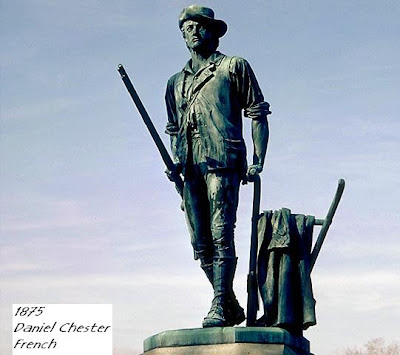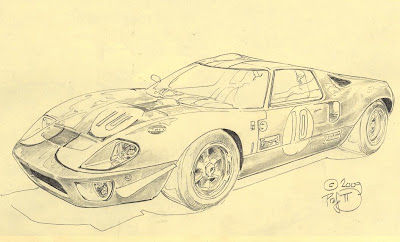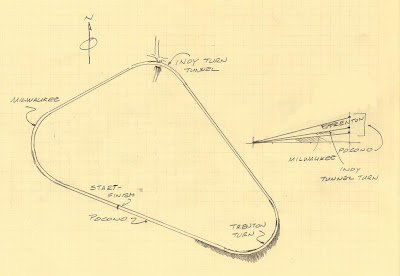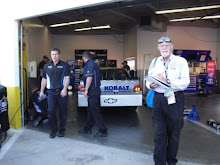 In early colonial times New York City was called New Amsterdam because it was owned by the Dutch, but it was a hotly contested area with the British.
In early colonial times New York City was called New Amsterdam because it was owned by the Dutch, but it was a hotly contested area with the British.The derisive Dutch term for Englishmen of the day was “John Cheese,”—due to their affinity for the food of the same name— the intended slur if pronounced with a Dutch accent sounds like “yan kees,” that became "Yankees." New England colonists of the British persuasion actually liked the term and adopted it.
The mascot for New Hampshire International Speedway is the "Quarter Minute Man," the pit crew that can at the drop of a yellow flag consistently turn fifteen second, one quarter of a minute, pit stops all day.
There are several “Minute Man” statues, but the pit crew “Quarter minute man” is patterned after the statue by Daniel Chester French (the real Minute Man is on display at Concord, MA, not New Hampshire, but it’s only 40 miles from NHIS)—French is better known for his statue of Lincoln which resides in the Memorial in Washington DC.
 New Hampshire is yet another 1960’s track, originally built as Bryar Speedway, a sports car road course replete with a lake in the middle of it. Too bad the lake’s been filled in, as it would make for an interesting challenge; if you are speeding leaving pit road you could end up in the lake. A new sign would have to be added inside the cars: “In case of a water landing your seat cushion may be used as a flotation device.”
New Hampshire is yet another 1960’s track, originally built as Bryar Speedway, a sports car road course replete with a lake in the middle of it. Too bad the lake’s been filled in, as it would make for an interesting challenge; if you are speeding leaving pit road you could end up in the lake. A new sign would have to be added inside the cars: “In case of a water landing your seat cushion may be used as a flotation device.”Rebuilt in 1989 by a new owner and changed into an oval which incorporates one turn of the old track, New Hampshire is among the slowest (average speed) tracks on the NASCAR Cup circuit; Dover and Rockingham (before it was cut from the schedule) also 1 mile tracks, are both much faster.
However, New Hampshire preserves the essence of racing: finding the elusive optimal combination of driver, set-up, engineering (gear ratio in particular), and racing smarts. This track is oval racing at its finest, purest form. And it is due to the geometry of the track.
 New Hampshire is among the flattest (2 to 7 degree progressive banking) of the 1 mile tracks and it also has the smallest turn radius, hence the lowest record qualifying speed (Phoenix, also a 1 mile track is much steeper —11 degree banking—and also has a larger radius turns, hence, qualifying speeds are about 2 mph faster than at New Hampshire). The relatively long drag race straights make up, to some extent, for the tight, flat turns.
New Hampshire is among the flattest (2 to 7 degree progressive banking) of the 1 mile tracks and it also has the smallest turn radius, hence the lowest record qualifying speed (Phoenix, also a 1 mile track is much steeper —11 degree banking—and also has a larger radius turns, hence, qualifying speeds are about 2 mph faster than at New Hampshire). The relatively long drag race straights make up, to some extent, for the tight, flat turns.To understand New Hampshire it is necessary to look at the detail of the corners.
 Due to the laws of physics it is actually rather easy to predict fastest qualifying speed based on the geometry of a race track. If Michigan is big and steep compared to a general trend line of track designs, then New Hampshire is way off the trend line in the other direction--way, way off the trend line: small radius turns and flat.
Due to the laws of physics it is actually rather easy to predict fastest qualifying speed based on the geometry of a race track. If Michigan is big and steep compared to a general trend line of track designs, then New Hampshire is way off the trend line in the other direction--way, way off the trend line: small radius turns and flat.
 Due to the laws of physics it is actually rather easy to predict fastest qualifying speed based on the geometry of a race track. If Michigan is big and steep compared to a general trend line of track designs, then New Hampshire is way off the trend line in the other direction--way, way off the trend line: small radius turns and flat.
Due to the laws of physics it is actually rather easy to predict fastest qualifying speed based on the geometry of a race track. If Michigan is big and steep compared to a general trend line of track designs, then New Hampshire is way off the trend line in the other direction--way, way off the trend line: small radius turns and flat.An index that describes a track by a combination of size (distance around one lap) and banking angle is a good indication of maximum average speed a racecar obtain. There are a couple of notable exceptions, Pocono being much slower than the track geometry would suggest (because it is three different turns defying all attempts to optimize a car set-up for all three). The other is New Hampshire, also much slower than the geometry of overall track length would suggest. Physics of turning, described in the previous graph on banking and turn radius explain this outcome.
Since next week is back to Daytona, juxtaposed to New Hampshire, it illustrates the extreme contrasts in track design philosophy. New Hampshire speeds, from its road course antecedents, are limited by technology: adhesion of the tires to the track, requiring that the driver slow down for the turns thus lap times are a mixture of driver, machine, and engineering.
Since next week is back to Daytona, juxtaposed to New Hampshire, it illustrates the extreme contrasts in track design philosophy. New Hampshire speeds, from its road course antecedents, are limited by technology: adhesion of the tires to the track, requiring that the driver slow down for the turns thus lap times are a mixture of driver, machine, and engineering.
 Daytona, like Indy, was designed with the idea of having a track where race car drivers could just wind it up and blow it out, no limit other than engine building and driver nerve: run wide freakin’ open the whole way around the track. In the fifty years between designing Indy (1908) and Daytona (1958) it was necessary to increase the banking of the track dramatically in order to run wide open.
Daytona, like Indy, was designed with the idea of having a track where race car drivers could just wind it up and blow it out, no limit other than engine building and driver nerve: run wide freakin’ open the whole way around the track. In the fifty years between designing Indy (1908) and Daytona (1958) it was necessary to increase the banking of the track dramatically in order to run wide open.Somehow, track developers don’t seem to bother looking at trend lines which are a consequence of engineering and technology. Engineers are forever trying to find a way to improve things, in the case of race cars, go faster, more reliably, using less and less fuel. It should have been evident from looking at the trend of qualifying speeds at the Indy 500.
 The sudden jump in qualifying speeds in 1971 and onward can be explained in a single word: aerodynamics, and wings in particular. From this point forward the essential problem with racing is going to be to limit racing speeds to keep the cars out of the grandstands.
The sudden jump in qualifying speeds in 1971 and onward can be explained in a single word: aerodynamics, and wings in particular. From this point forward the essential problem with racing is going to be to limit racing speeds to keep the cars out of the grandstands.The problem of going fast, with a reliable machine had been solved; and it overwhelmed all then extant track designs.
In just a year more than a decade of racing Daytona was faced with the same problem, slowing the cars down in the interest of safety: for both drivers and spectators. The first attempt at this was to limit engine size, but NASCAR doesn’t seem to understand how engineers think and this was simply a delay not a change.
 The engineers quickly found ways of increasing power even in a reduced engine block (the 358 cubic inch displacement rule still in place today). Finally, in 1988 restrictor plates were introduced and now cars are limited by a rules committee; engineering and driving have been marginalized.
The engineers quickly found ways of increasing power even in a reduced engine block (the 358 cubic inch displacement rule still in place today). Finally, in 1988 restrictor plates were introduced and now cars are limited by a rules committee; engineering and driving have been marginalized. Engineering and technology overwhelmed the track design,...20 years ago.
 But real racing lives on, go to New Hampshire and see it; on the way there stop in Philadelphia, Boston, and Concord (both of them) and walk the trail of American history, it’s a fascinating tour.
But real racing lives on, go to New Hampshire and see it; on the way there stop in Philadelphia, Boston, and Concord (both of them) and walk the trail of American history, it’s a fascinating tour. And look for other Daniel Chester French (1850-1931) statues along the way, he was the preeminent sculptor of the day.



















